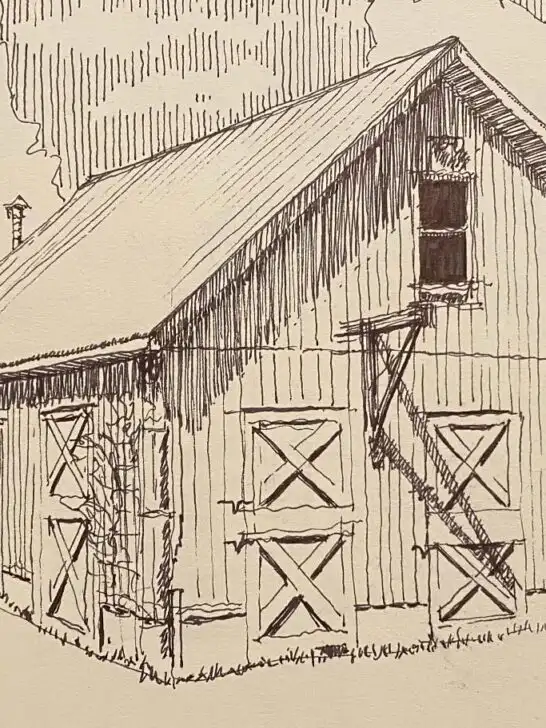Creating house sketches and paintings is a wonderful way to capture architectural beauty, express creativity, and improve artistic skills. Whether you’re a beginner or an experienced artist, drawing and painting houses can be both rewarding and challenging. From charming cottages to grand mansions, the variety of architectural styles offers endless inspiration.
In this article, we’ll explore 30 amazing ideas to help you sketch and paint houses with confidence.
1. Classic Architectural Watercolors
Watercolors are excellent for capturing the soft, atmospheric beauty of houses. They create a balance between structure and fluidity, making architectural paintings feel lively and dynamic.
- Example: The first image showcases a beautifully painted brick house in watercolor. The combination of ink outlines with delicate color washes adds depth and realism.
- Try it yourself: Focus on subtle color transitions and wet-on-wet techniques to achieve a soft, blended effect.
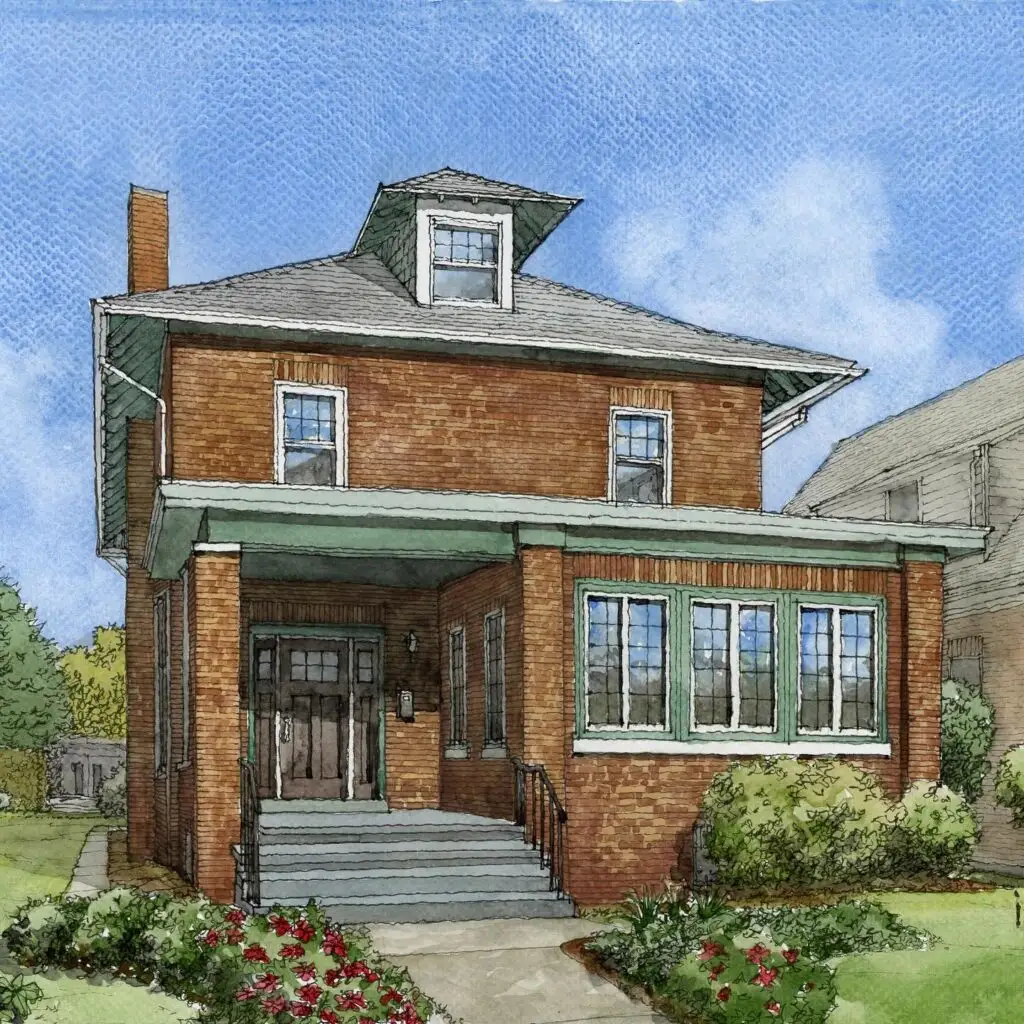
2. Ink Sketches with Architectural Detail
Ink sketches emphasize the strong structural elements of buildings. Artists use fine liners or fountain pens to create intricate lines and hatching for depth.
- Examples: The second and third images depict ink sketches of townhouses and urban buildings. They highlight structural details through precision linework.
- How to try it: Use a fine-tip pen to outline the house, then add cross-hatching or stippling for texture and shading.
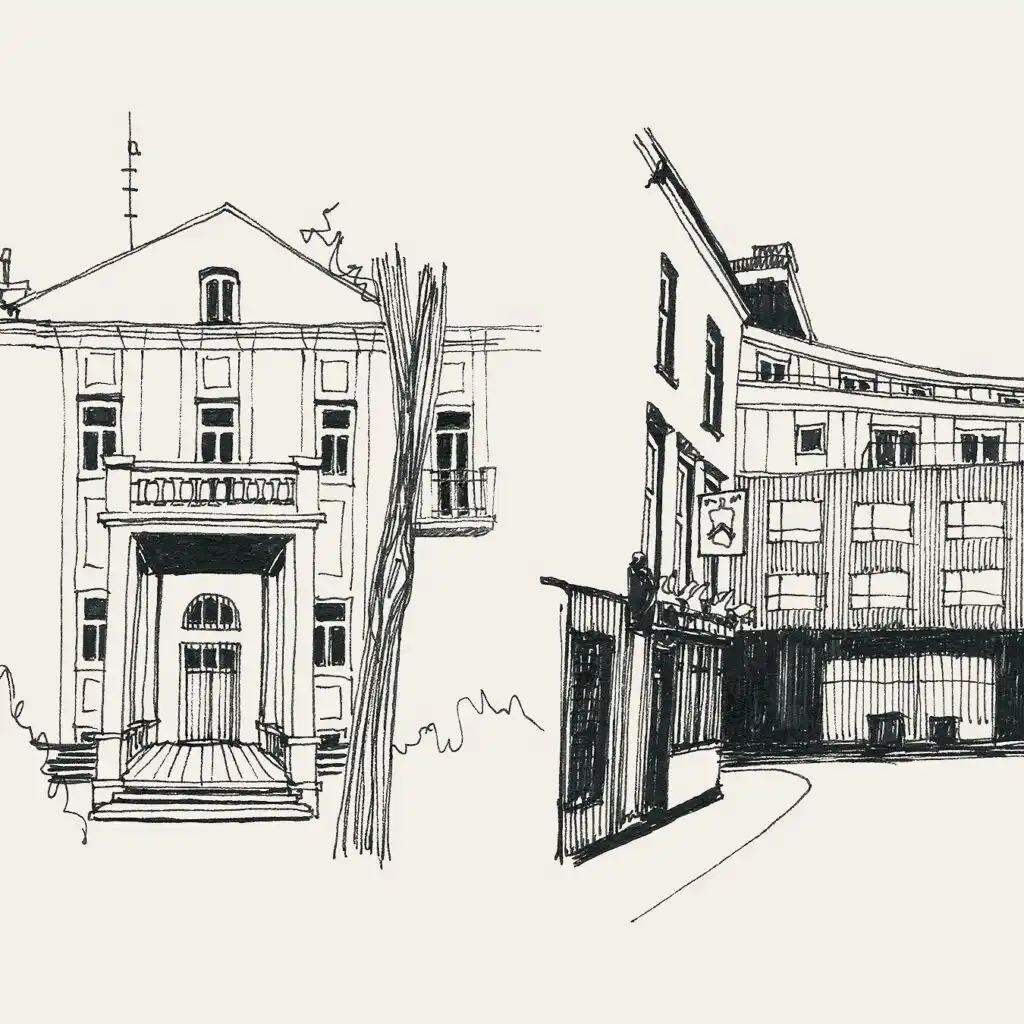
3. Pen-and-Ink Illustrations with Nature Integration
Some sketches incorporate detailed landscaping, blending houses with their natural surroundings for a more organic feel.
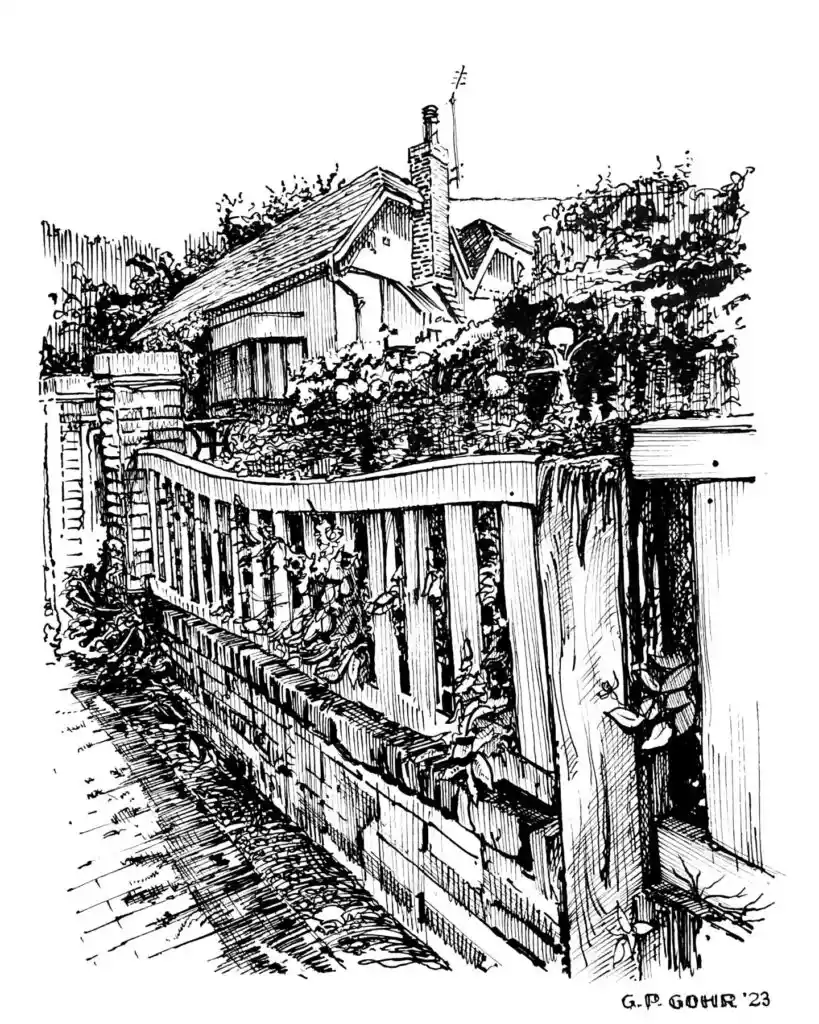
- Example: The fourth image features a house behind a detailed wooden fence and lush foliage, demonstrating how textures create an immersive scene.
- Pro tip: Experiment with layering different line weights to distinguish between architectural elements and nature.
4. Abstract and Geometric House Art
Abstract house paintings take a more imaginative approach, using geometric forms and bold colors to depict architecture in an expressive way.
- Examples: The fifth and tenth images present cubist-inspired interpretations of villages, breaking down forms into simplified shapes with a rich color palette.
- How to experiment: Start with a sketch of a real house, then deconstruct it into geometric elements and reassemble it with exaggerated angles and abstract hues.
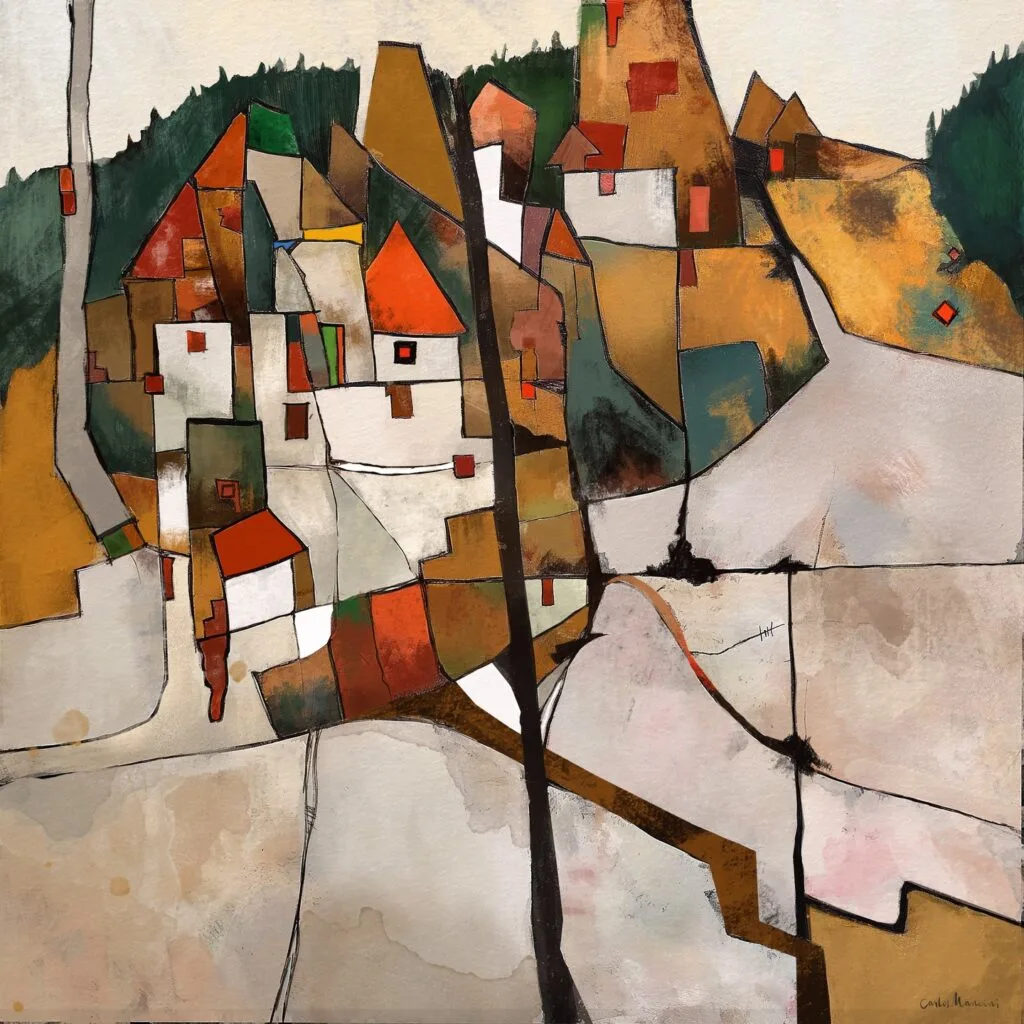
5. Barn and Rustic Structures in Ink
Rustic barns and farmhouses make for wonderful sketches, often drawn in sepia tones or black-and-white ink to highlight their aged, weathered charm.
- Example: The sixth image shows a finely detailed barn sketch with cross-hatching to emphasize texture.
- Pro tip: Use varied line density to differentiate wood grain, roof shingles, and metal fixtures.
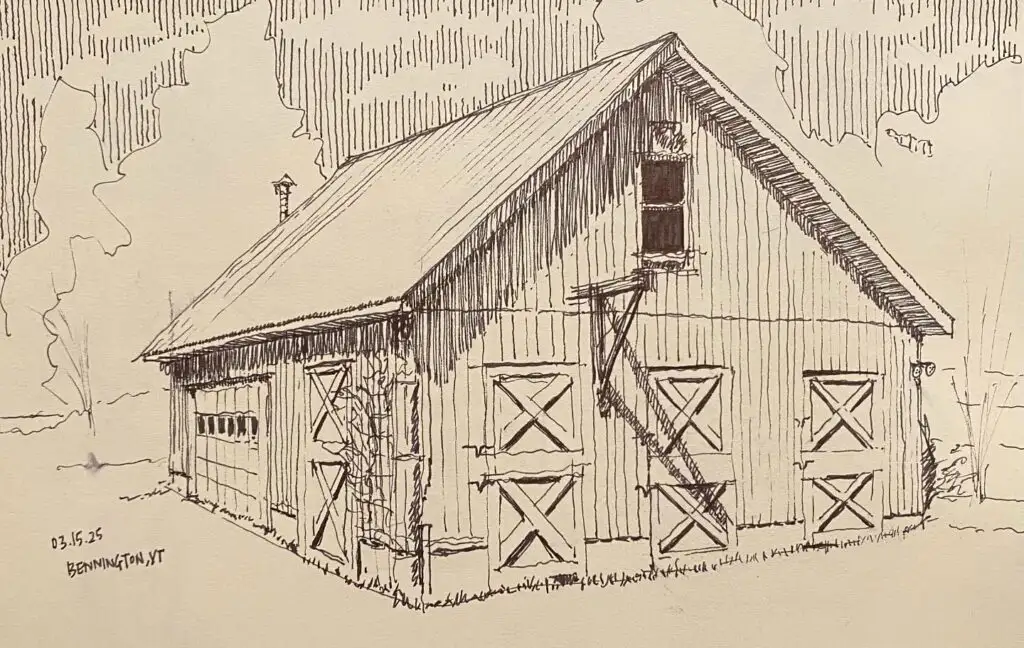
6. Coastal and Seaside Cottage Paintings
Seaside cottages often have vibrant colors and a breezy, relaxed atmosphere, making them ideal subjects for watercolor or gouache.
- Example: The seventh image features a charming blue beach house with a red roof, set against a bright sky and ocean waves.
- Try this approach: Use wet-on-dry techniques in watercolor to define crisp edges while maintaining soft atmospheric elements.
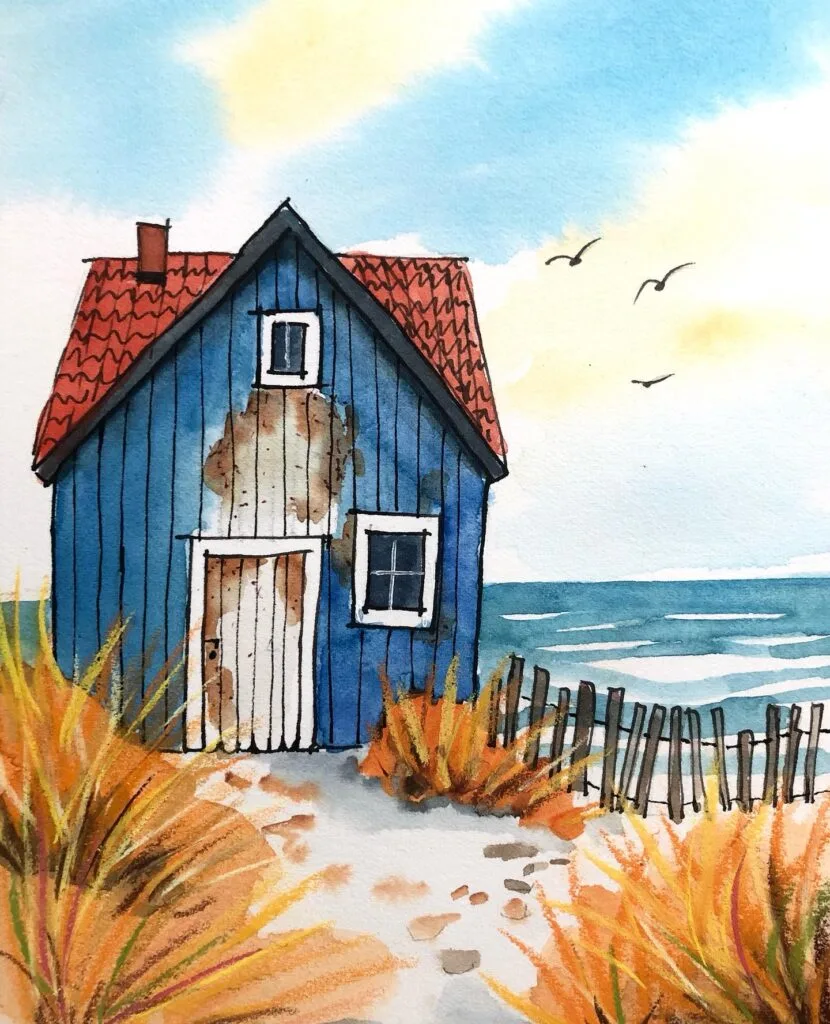
7. Botanical-Inspired House Sketches
Some house sketches integrate greenery, vines, and floral details to create a romantic and lively feel.
- Example: The eighth image showcases a stately home intertwined with overgrown ivy and flowering plants, combining detailed architecture with soft natural elements.
- How to experiment: Use a mix of ink and watercolor to highlight plant textures while maintaining the house’s structural clarity.
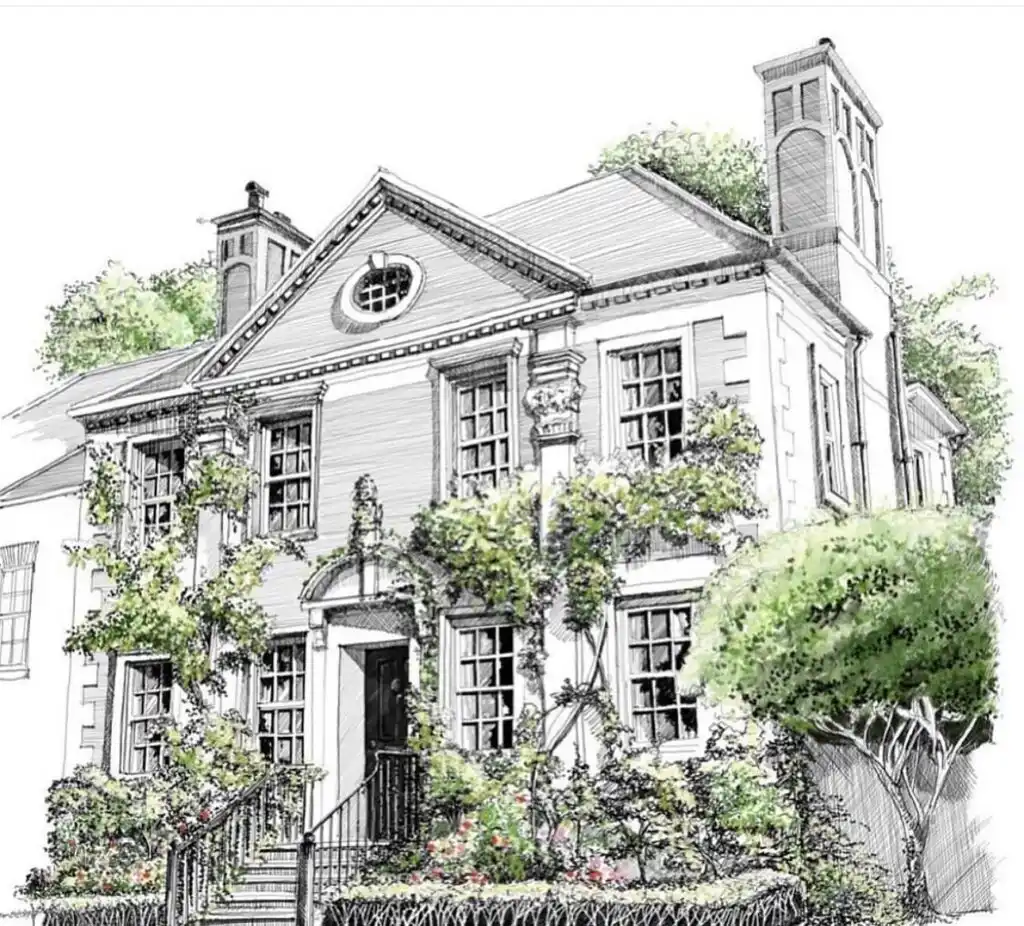
8. Old-World European Architecture in Watercolor
Historical buildings, such as medieval towers and European villages, make for compelling watercolor subjects with rich textures and weathered facades.
- Example: The ninth image presents a soft, atmospheric painting of an old European stone building, with warm, aged tones.
- How to achieve this: Mix dry-brush techniques with wet washes to create textured surfaces and light effects.
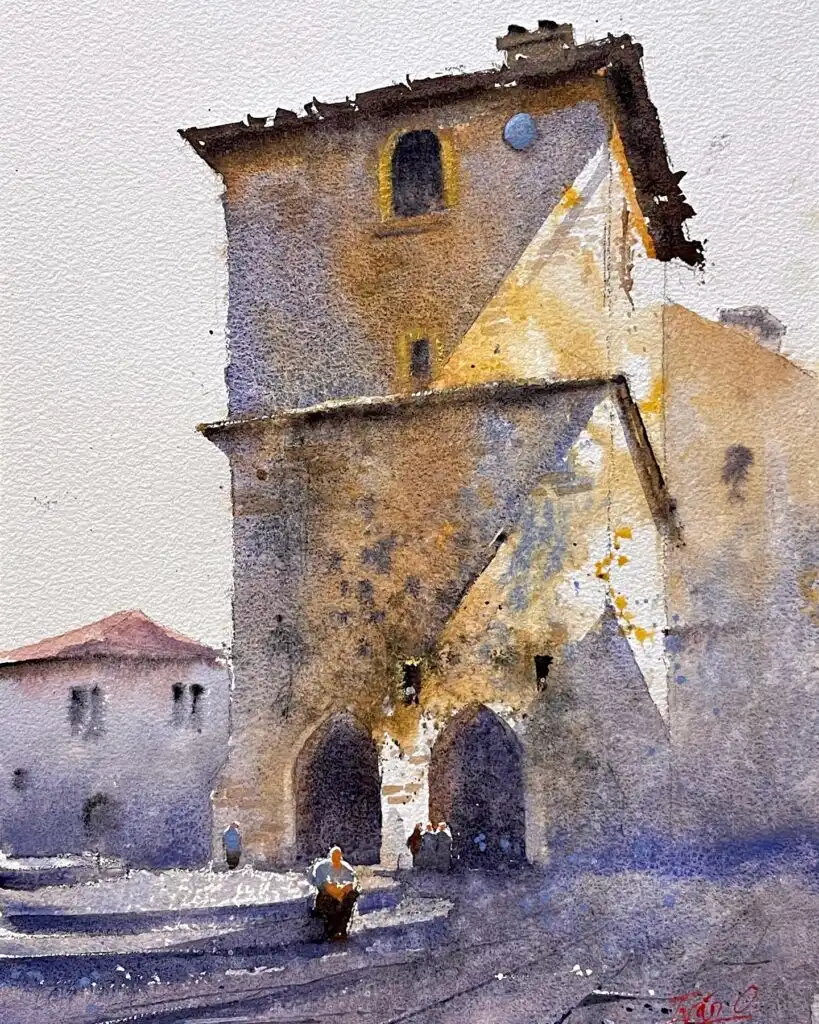
9. Futuristic and Contemporary Architectural Art
Modern homes, high-rises, and futuristic cityscapes can be depicted in a minimalist or surrealist style, often playing with light, shadow, and geometric abstraction.
- Example: The tenth image shows a stacked, contemporary housing arrangement with an artistic blend of muted and bold colors, emphasizing an urban aesthetic.
- How to explore this style: Use sharp, angular lines, limited color palettes, and digital tools to achieve a clean, futuristic look.
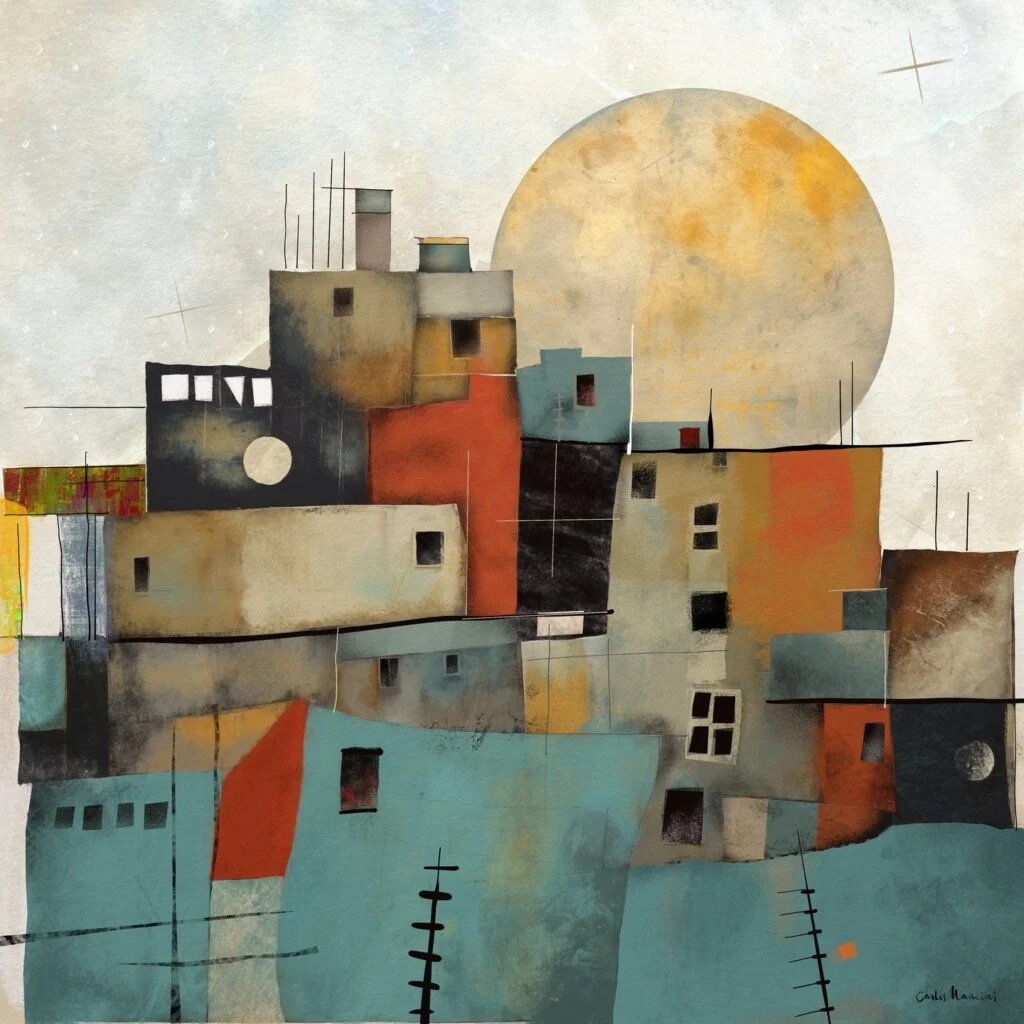
10. Weathered Rural Cottages and Cabins
Simple wooden cottages and rustic cabins offer a nostalgic charm, often depicted with delicate ink strokes or subtle watercolor washes.
- Example: The next design showcases a wooden cabin sketch with fine ink details, highlighting aged wood textures and a rural atmosphere.
- How to try this style: Use cross-hatching and fine linework to emphasize the aged wood, and incorporate shading to create depth.
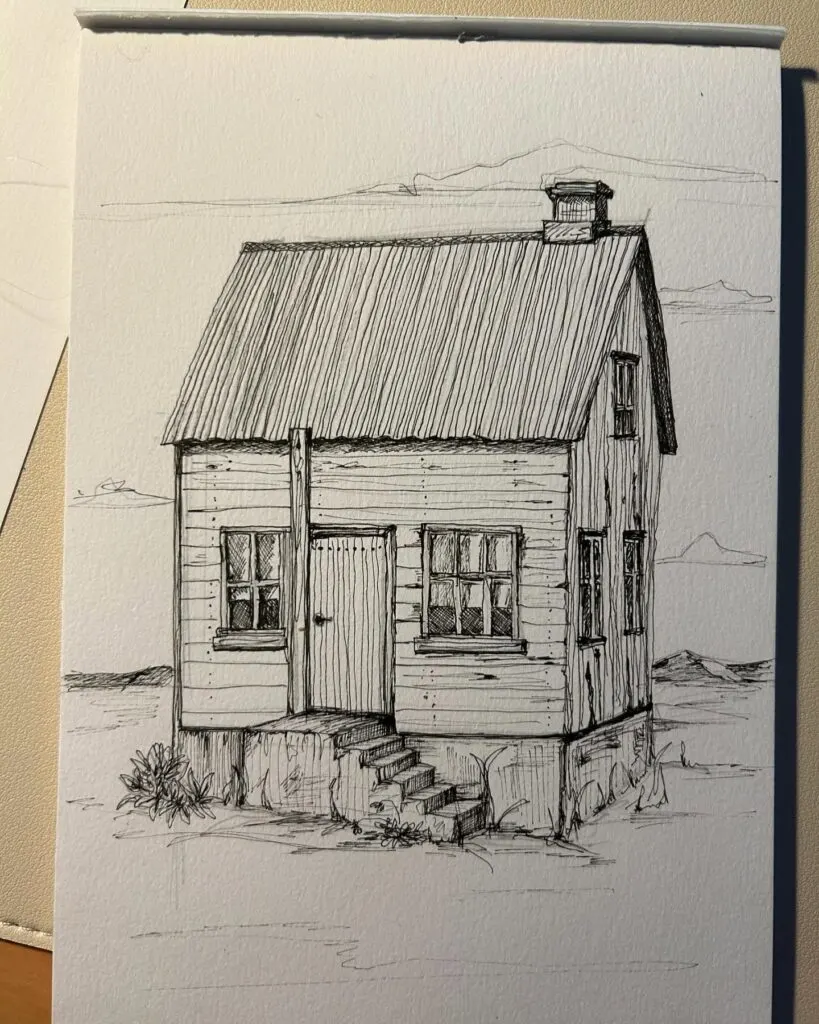
11. Traditional Asian Storefronts and Urban Buildings
Detailed sketches of traditional architecture, such as Japanese storefronts or markets, capture the essence of bustling urban life with a cultural touch.
- Example: The second image presents a hand-drawn ink sketch of a Japanese-style storefront, rich with textures and minute details.
- How to approach this style: Use sepia-toned paper or textured backgrounds to enhance the old-world charm, and focus on shading techniques to add realism.
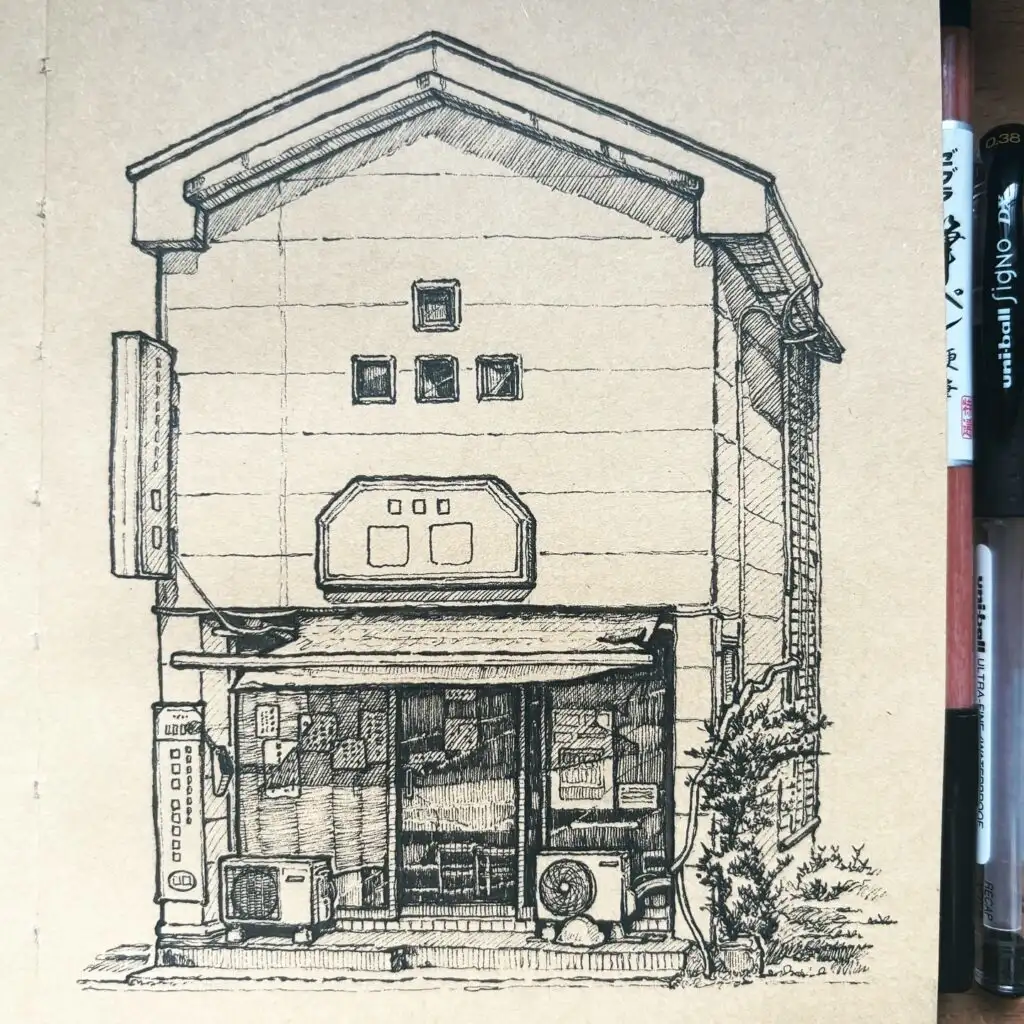
13. Urban Ink Sketches with a Cultural Narrative
Cityscapes and old-world buildings in dense urban settings tell a story of time and change, making them an excellent subject for architectural sketching.
- Example: The image is an intricate ink sketch of a Hong Kong street scene, capturing traditional architecture alongside modern elements like air conditioning units and signage.
- Tips for sketching urban scenes: Use quick strokes to define structure, but add small details like balconies, window frames, and hanging signs to bring life to the composition.
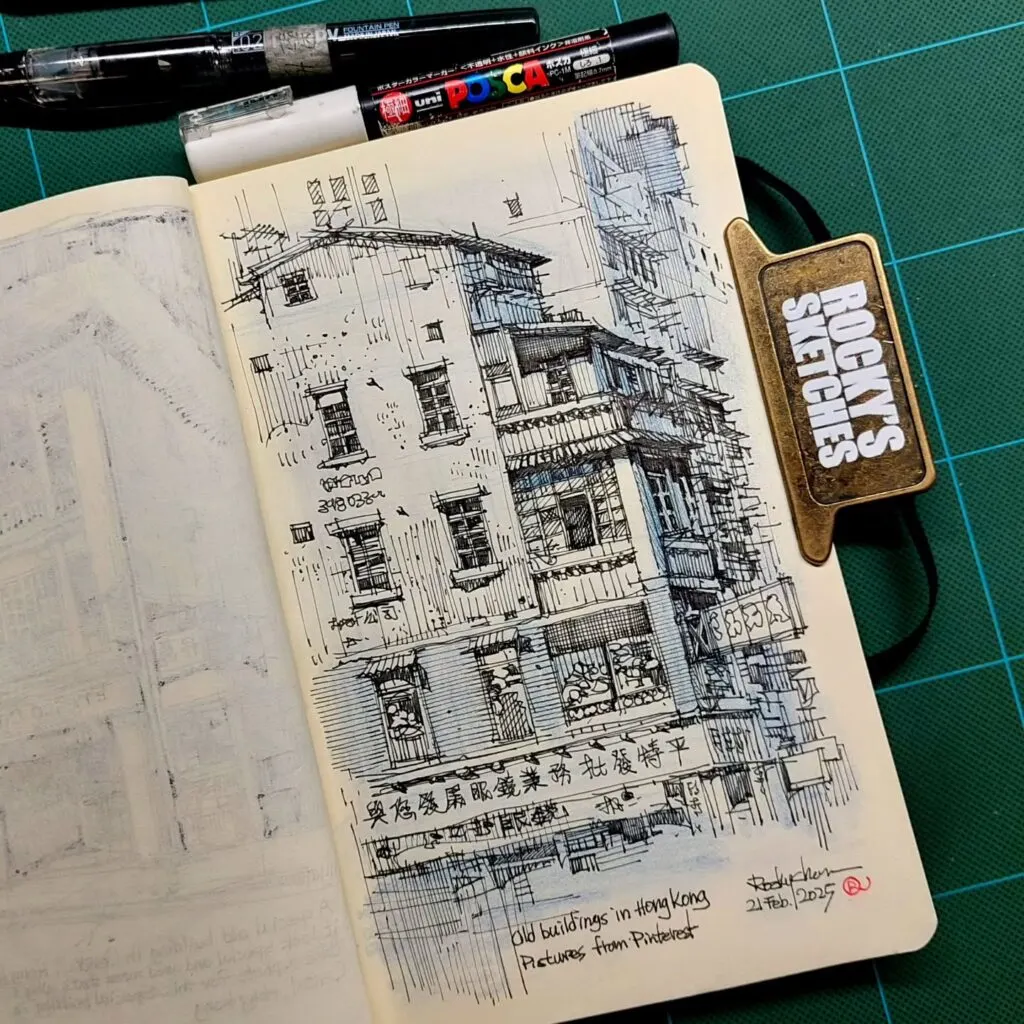
12. Stone Cottages and Textured Ink Drawings
Stone houses provide a fantastic subject for detailed ink illustrations, offering an opportunity to experiment with shading and texture techniques.
- Example: The image showcases a meticulously detailed stone house, where individual stones and architectural features are brought to life through cross-hatching and stippling.
- How to approach this style: Focus on depth by using varied shading techniques—darker cross-hatching for shadows and lighter stippling for stone texture.
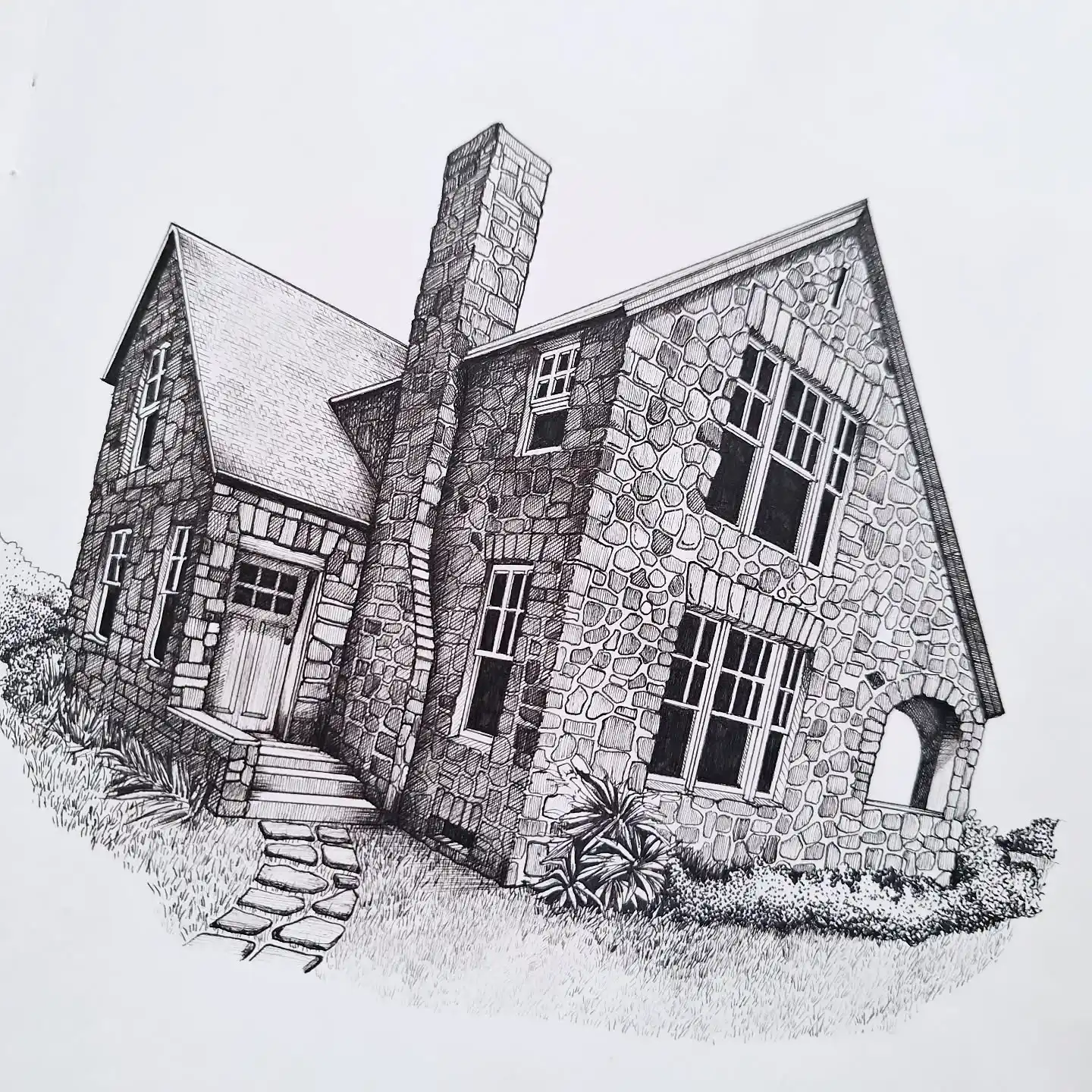
Also check out:
1. Enhancing Perspective and Structure
- To improve the accuracy of your house sketches, check out Mastering the Basics of Perspective Drawing: 15 Quick Tips for Beginners for essential depth and proportion techniques.
- For those working from real-life references, Mastering the Art of Observational Drawing: A Beginner’s Guide will refine your ability to capture architectural details.
2. Best Tools for House Sketching and Painting
- Choosing the right paper matters—here’s a guide to the best sketchbooks for artists to ensure durability and texture for ink and watercolor work.
- For fine-line architectural sketches, explore the Best Biros for Drawing and Shading to find pens that offer precision and ink control.
- If you prefer mechanical pencils for crisp architectural details, check out Best Mechanical Pencils for Drawing for top artist picks.
- Interested in house paintings with bold colors? This Acrylic Paints Guide helps you pick the right paints for vibrant, long-lasting results.
- For traditional oil-painted architecture, here’s a Beginner’s Guide to Oil Paint Sets to help you get started.
3. Creative House Art Styles and Inspirations
- Looking for colored pencil techniques to add depth to your sketches? Try these 10 Creative Colored Pencil Drawing Ideas for inspiration.
- If you love watercolor, blend techniques from Colorful Creatures: 10 Inspiring Watercolor Animal Painting Ideas into your house paintings for fluid and organic effects.
- Abstract artists will enjoy these 30 Abstract Landscape Painting Ideas for unconventional house compositions.
- For an architectural take on Cubism, this guide to Cubist Art will inspire geometric house depictions.
4. Sketching and Painting Exercises for Practice
- If you’re considering selling your house sketches and paintings, explore 10 Fast-Selling Art Project Ideas for potential commercial opportunities.
- Need fresh ideas for your sketchbook? Check out 50 Sketchbook Prompts to Inspire You to push your creativity further.
14. Expressive and Bold Color House Paintings
Using bold, unconventional colors can transform an ordinary house into an expressive piece of art, breaking away from realism to explore emotions and atmosphere.
- Example: The image features a vibrant house painted in shades of deep purple and orange, creating a striking contrast with the surrounding grass and sky.
- How to experiment: Try using complementary colors (e.g., blue and orange, purple and yellow) to create a vivid, energetic feel. Acrylics and pastels work well for this technique.

Final Thoughts
Sketching and painting houses is more than just capturing structures—it’s about telling stories through art. Whether you prefer the delicate washes of watercolor, the precision of ink sketches, the richness of oil pastels, or the bold abstraction of geometric compositions, each technique brings a unique perspective to architectural art.
From rustic barns and seaside cottages to urban storefronts and futuristic homes, the possibilities for house-themed artwork are endless. Experimenting with different styles, textures, and mediums allows you to develop your artistic voice while honing your skills in perspective, shading, and composition.
Use these 30 ideas as a starting point to explore your creativity. Try blending techniques, adding unique details, or even creating your own imagined dream house. Whether you aim for realism or abstraction, each sketch or painting will be a reflection of your artistic vision.

